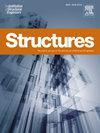Lateral seismic performance analysis of diamond-shaped pylon based on equivalent single-tower model
IF 3.9
2区 工程技术
Q1 ENGINEERING, CIVIL
引用次数: 0
Abstract
To study the lateral elastic-plastic seismic performance and failure mechanism of diamond-shaped pylon in long span cable-stayed bridges under extreme seismic excitation, a typical long span cable-stayed bridge was taken as the prototype and its finite element model was established using SAP2000. According to the principle of self-weight effect, lateral stiffness and lateral mode equivalence, a simplified method of diamond-shaped pylon is proposed. The entire bridge model is simplified into an equivalent single-tower model. Two fiber finite element models were established in OpenSees. Comparative analyses of static characteristics and related results were conducted to assess the applicability of single-towers with different material property. The reliability of the models was verified by comparing quasi-static test results. A systematic investigation of the lateral seismic performance of diamond-shaped pylon was carried out at three hierarchical levels: the structure, cross-section, and material. The analysis identified the yielding sequence and damage mechanisms. An in-depth analysis of material damage in diamond-shaped pylon offers essential data to support the investigation of their failure mechanisms under severe seismic excitations. The analysis results reveal that the lower area of the middle crossbeam is the most vulnerable region in the diamond-shaped pylon. The failure mechanisms consist of tensile yielding of the steel reinforcement, subsequent cracking compressive strain in the concrete, and final concrete crushing failure.
基于等效单塔模型的菱形塔横向抗震性能分析
为研究大跨度斜拉桥菱形塔在极端地震作用下的侧向弹塑性抗震性能及破坏机理,以一座典型大跨度斜拉桥为原型,利用SAP2000软件建立了大跨度斜拉桥的有限元模型。根据自重效应、侧移刚度和侧移模态等效原理,提出了菱形塔的简化方法。将整桥模型简化为等效单塔模型。在OpenSees中建立了两个光纤有限元模型。对比分析了不同材料性能的单塔的静力特性及相关结果,以评估其适用性。通过对准静态试验结果的比较,验证了模型的可靠性。从结构、截面和材料三个层次对菱形塔的横向抗震性能进行了系统的研究。分析确定了屈服顺序和损伤机理。对菱形塔材料损伤的深入分析为研究其在强地震作用下的破坏机制提供了必要的数据支持。分析结果表明,菱形塔中横梁下部是最脆弱的区域。破坏机制包括钢筋的受拉屈服、随后的混凝土开裂、压应变和最终的混凝土破碎破坏。
本文章由计算机程序翻译,如有差异,请以英文原文为准。
求助全文
约1分钟内获得全文
求助全文
来源期刊

Structures
Engineering-Architecture
CiteScore
5.70
自引率
17.10%
发文量
1187
期刊介绍:
Structures aims to publish internationally-leading research across the full breadth of structural engineering. Papers for Structures are particularly welcome in which high-quality research will benefit from wide readership of academics and practitioners such that not only high citation rates but also tangible industrial-related pathways to impact are achieved.
 求助内容:
求助内容: 应助结果提醒方式:
应助结果提醒方式:


